Take A Walk In The Wild Style
Richard Boch talks to Fab 5 Freddy, Jeffrey Deitch, Lady Pink, and legendary Wild Style director, Charlie Ahearn to celebrate the 40th anniversary of the first-ever Hip Hop film, Wild Style.
Richard Boch talks to Fab 5 Freddy, Jeffrey Deitch, Lady Pink and legendary Wild Style director Charlie Ahearn about the resounding impact of the first-ever Hip Hop motion picture.
June 1980. The show took place in a broken-down massage parlor at the corner of Seventh Avenue and Forty-first Street. It was an all-day, all-night renegade mash-up of art, sculpture, video, fashion and music. It was the Times Square Show—Art of The Future—and it set the tone and the pace and gave the idea that anything’s allowed new meaning. Less than one year later, April 1981, Fab 5 Freddy Brathwaite co-curated Beyond Words at the Mudd Club. Several months passed and by September 1981, Patti Astor, the downtown actress and scene-stealer started Fun Gallery in the East Village. The floodgates blew open and the street slowly moved indoors.
By then Fab and filmmaker Charlie Ahearn had already started making trips to the Bronx, but it was that perfect moment back in 1980—a meeting of the minds when Fab first met up with Charlie at the Times Square Show, that set things in motion. By 1981 Ahearn began shooting Wild Style and a feral tangle of talent became a vibrant collective of young Graffiti artists playing versions of themselves in what would become Ahearn’s landmark film.
With all that was happening, kids from the Bronx headed south and the way-uptown crowd made their way to the downtown club scene. It was a new community coming together as the result of those earlier connections along with the like-minded spirit of the street. Boomboxes went full volume and creativity followed suit.
It was all fast and furious and it marked a moment in time—it was history in the making told by those who were there—a history without pretense and without baggage. By 1983 Wild Style had become a joyous achievement that over the course of time still rings true and allows us to celebrate not just Ahearn’s filmmaking but the gift that his vision and commitment—along with that of so many other young artists—gave us, and continues to give.
I recently had the chance to speak with Charlie, Fab 5 Freddy and Lady Pink—along with Jeffrey Deitch, whose Wooster Street gallery is presenting the Wild Style 40 Anniversary Exhibition. It’s an opportunity to not just look back—but to look and move forward.
Let’s hear what they had to say.
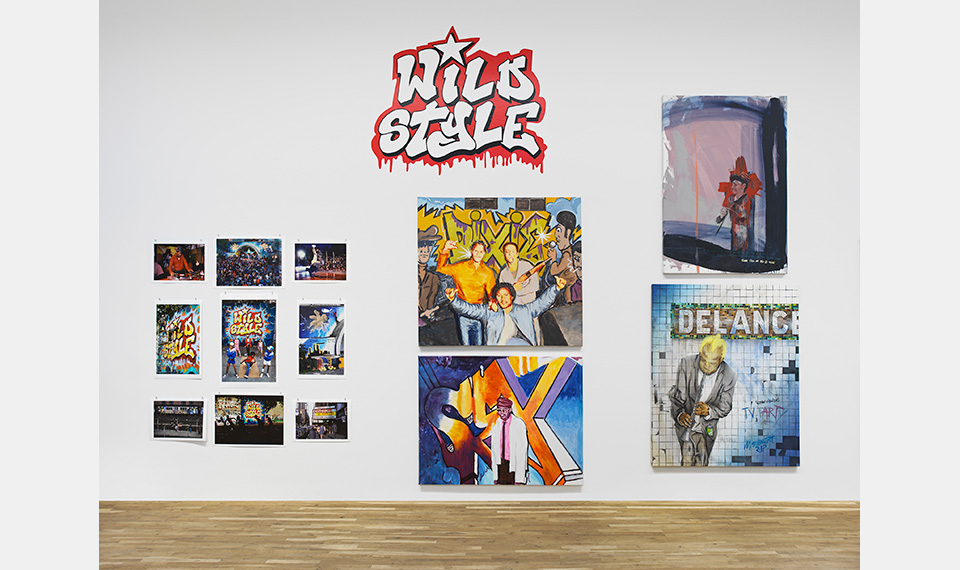
Photo by Genevieve Hanson. Courtesy of the artists and Jeffrey Deitch, New York
Hi Jeffrey. Deitch Gallery has always been beyond receptive and inclusive to so many variations on Pop Culture, contemporary and historical themes and ideas whether it be Stephen Sprouse, Walter Robinson, Kenny Scharf or Alan Vega to name just a few of the New York City “locals.” Wild Style 40 speaks to that New York history as we watch that particular 1983 moment move forward. What does Wild Style mean to you personally?
Wild Style celebrates not just the 40th Anniversary of the seminal film that helped spread the culture of Hip-hop, Graffiti, break dancing and streetwear around the world. It celebrates a dynamic community of artists. It’s also remarkable that the film starred the major artists in the movement playing versions of themselves. Several of those artists are no longer with us, but the community that created Wild Style is still vibrant and the artists remain friends.
It is amazing that what is perhaps the most influential art movement since Pop Art was created by New York City teenagers.
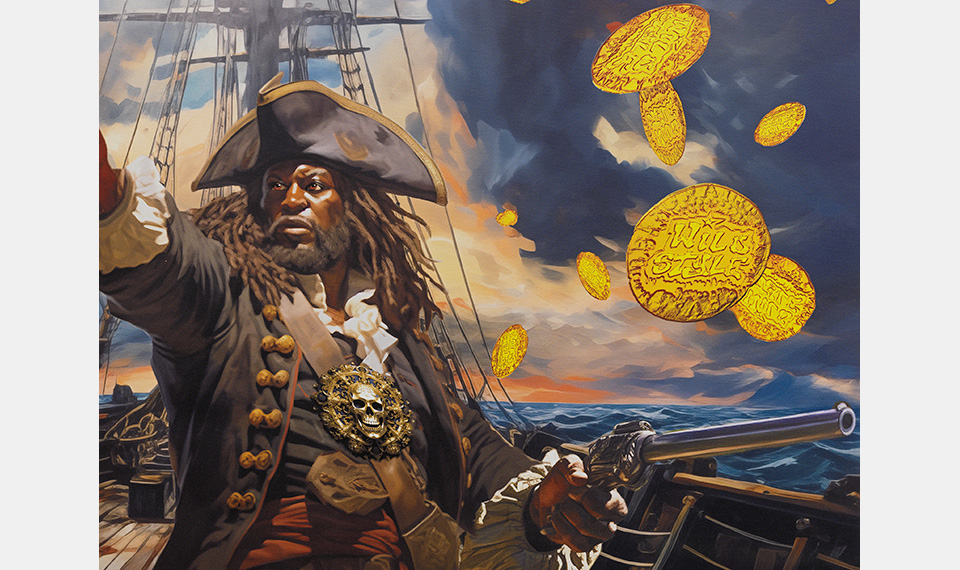
Wild Style, Treasure on the High Seas, 2023, Fab 5 Freddy. Photo by Genevieve Hanson. Courtesy of the artist and Jeffrey Deitch, New York
Hey Fred. I was thinking as I was reaching out to you how we’ve both seen a lot happen in New York City since the very early 1980’s but when it comes to Graffiti, Hip Hop and Wild Style you were in the thick of it as both a player and a pioneer. Your participation and ability to work with and influence so many different artists, whether it was Charlie, Debbie Harry, The Clash or even getting sampled by the likes of Herbie Hancock was and is major.
Looking back and most importantly looking forward, what does Wild Style tell you about art, New York City and yourself?
Hello Richard how are you? It’s good to say hey and hi and it’s good to take time to answer this question of yours. You know, since the 50th Anniversary of Hip-hop as well as Wild Style 40 there’s been a lot of opportunities for me to reflect and think deeper about it than I have. You’re well aware of the scene that we and so many of our friends were part of even though today is such a different time and place. Technology over the last many or few decades and things changed on a continuum—so it’s really been a blessing and very humbling that the ideas I had not only worked out as planned, but beyond expectations. I wanted to help spark a revolution or a movement like I saw happen as a young kid in the Sixties. It was exciting to me and I wanted to get into a similar space and get in from the beginning—that was my plan. As a person of color, I wanted to get in any way I could, whether it was through the floor or down the chimney Santa Claus style—that was my mission. People like Debbie Harry, Chris Stein and Glenn O’Brien were like mentors—the guys from The Clash saw what was happening too. Meeting Charlie Ahearn who was ready to dive right in with Wild Style and take it to the next level along with Blondie’s song Rapture, that was all really monumental, and the foundation of what became a global movement and culture. What Wild Style tells me about myself and New York City is that all the possibilities that I saw and that I moved on came to fruition. MTV put me in front of millions of people and laid a foundation for me that others connected with.
Getting back to Wild Style, we intended to make a film that would rock the house—downtown, uptown, the Bronx, ghetto to ghetto—and we made things happen.
I’m just humbled man, and I’m grateful to be in the mix.
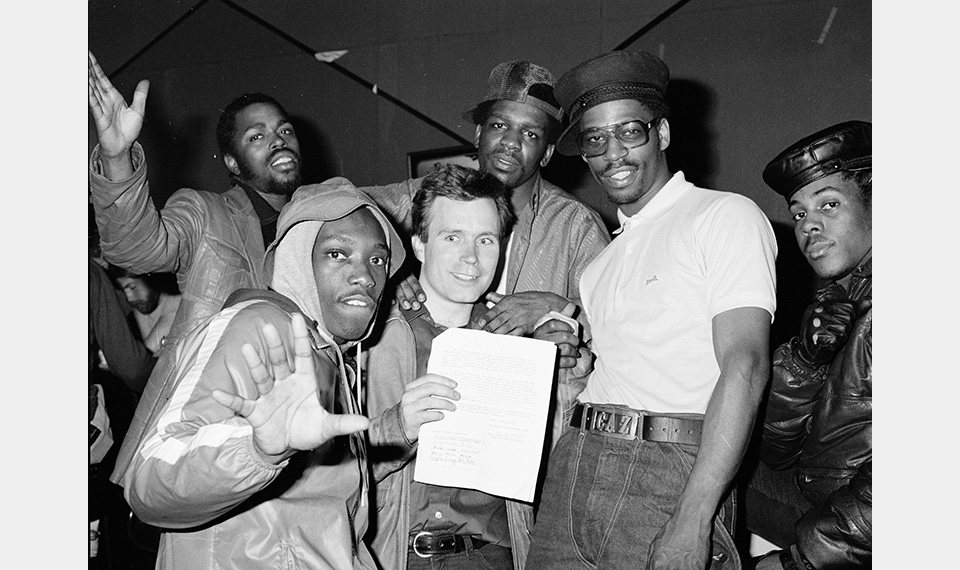
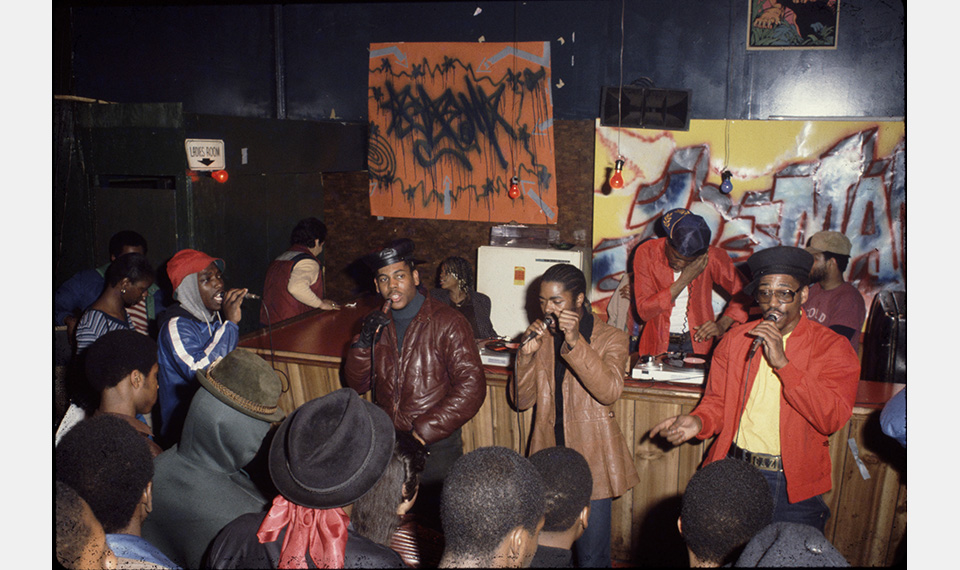
Charlie Ahearn and The Cold Crush Brothers at The Dixie Club, 1981; Cold Crush Brothers at The Dixie Club filming of Wild Style, 1981. Photos by Joe Conzo, courtesy of the artist and Jeffrey Deitch, New York
Hey there Charlie. The new Wild Style Anniversary Exhibition at Jeffrey Deitch is quite something and your 1983 film Wild Style was groundbreaking, to say the least. With a crew of Graffiti and Hip Hop pioneers playing versions of themselves, you managed to go from reality to hyper-reality and back. In doing so you helped nurture not just a scene but a movement that is as relevant today, if not more so than when the film was released. What did Wild Style, including your relationship with those artists and their work, mean to you both then and now?
Hey Richard—after having spent last night at Deitch (gallery) with Fab 5 Freddy, Lady Pink and Lee Quinones raking over divergent early memories, it was leading us all through how we met and made the movie Wild Style. Fred came to me at The Times Square Show with an idea to make a movie about Hip-hop and Graffiti. He had seen my Deadly Art of Survival movie posters around Lee’s neighborhood. I was obsessed with working with Lee since shooting his Graffiti handball courts (murals) and I asked Fred to bring him by the next morning. They came by and busted out (illegally) a FAB5 piece on the wall by The Times Square Show. Not long after Fred and I went to an outdoor Bronx jam and met Busy Bee who thought we were the cops. I said I was making a film about the Hip-hop scene so Busy took me out on the stage and said to the crowd, “This is Charlie Ahearn, my film producer, and WE’RE making a movie about the Hip-hop scene. Everything was that fast and direct.
I went to Henry Chalfant’s photo exhibition of subway Graffiti and all the writers showed up. That is where I took a photo of a young girl in a Pink Panther t-shirt with thick black hair surrounded by kids holding piece books (sketchbooks). I mentally cast her in the movie. At Deitch last night, Pink said she was 16 years old and had hardly painted anything at that moment. Lee, who was then the silent yet the most wanted outlaw artist, revealed that when he entered the long-gone OK Harris Gallery in SoHo, the crowd seemed to open up. He saw Lady Pink and he knew she was a subway writer. Lee said that he tried to say hello and she looked away indifferently.
That was all it took. The story was writing itself and that was enough.
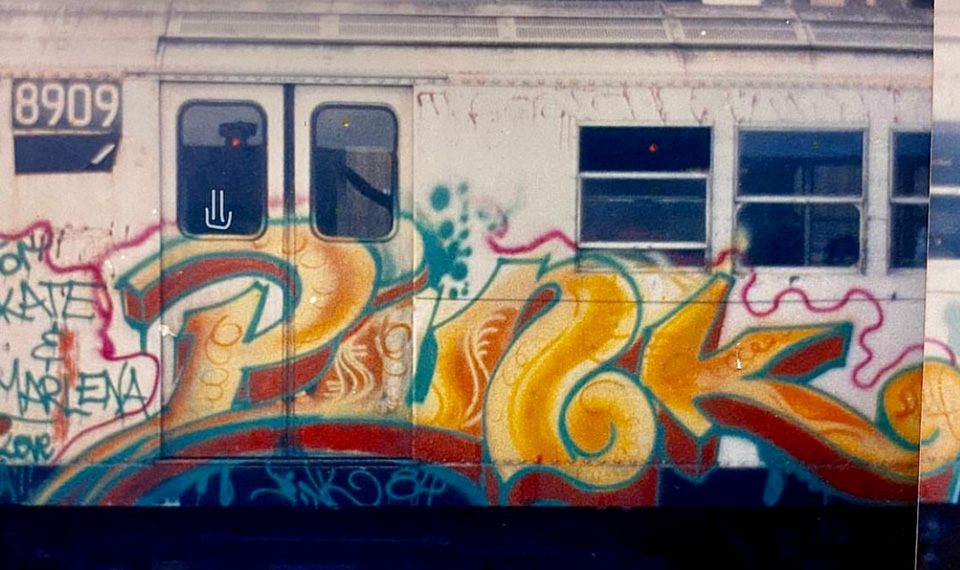
Uptown Train 1984. Courtesy of Lady Pink
Hi Pink. You were fifteen or sixteen when you began expressing yourself by way of Graffiti, involving yourself in a subculture that came to rival Pop and Expressionism in the sense of lasting importance and influence. Then somewhere in the mix of high school, running the streets and tagging trains you gained a reputation among your peers. Initially, you were the only girl on the scene but even in those early days of what was to become Wild Style, you sought to change that by encouraging more young women to get involved.
When you look back to those early days of Graffiti and Hip-hop and think about where you are today, how does it feel to be such a big part of the Wild Style legacy and celebration?
Hi Richard, here goes. Wild Style has been with me my whole adult life. I took a starring role at the age of 16 when everything was new and fun and I was down for anything crazy. I never imagined that it would actually be released in theaters, much less turn into a historic and iconic piece of culture—it was so low-budget! I didn’t sign up to be a Hip-hop icon but that’s how we’ve been portrayed, labeled, stereotyped. I’m not that comfortable in the limelight but in a way I’ve been trained doing Wild Style publicity to handle it since I was a teenager—and it still does come in handy being a well-known street artist.
Some of us in the Graffiti community feel that Graffiti isn’t really Hip-hop and that’s really just the entertainers. There were always Graffiti writers of all races in every corner of New York City that were never exposed to Rap or breakdancing yet we’ve all been lumped together in order to neatly sell it. Hip-hop has not defined me, especially since it’s changed over the years with thug lyrics and disrespect towards women—that does not appeal to me. Being a female in the Hip-hop culture can make it difficult to have dignity and get respect and I feel for my sisters.
As for Wild Style, it feels amazing to be part of such an iconic film, the first of its kind that inspired so many people around the world. I’m happy to still be friends with Charlie Ahearn and the rest of the cast—forever grateful to him for having the gumption to make this crazy film. He captured a slice of history like no other.
***
Wild Style 40, Curated by Carlo McCormick, runs through January 13, 2024, at Deitch Gallery, 18 Wooster Street, New York.
Instagram: @jeffreydeitchgallery
Website: deitch.com
INTERVIEW Richard Boch with special thanks to Fab 5 Freddy
FEATURED PHOTOGRAPH: Cold Crush Brothers at The Dixie Club filming of Wild Style, 1981. Photo by Joe Conzo, courtesy of the artist and Jeffrey Deitch, New York
PHOTOGRAPHY ©️ Courtesy of the artists and Jeffrey Deitch, New York
Richard Boch writes GrandLife’s New York Stories column and is the author of The Mudd Club, a memoir recounting his time as doorman at the legendary New York nightspot, which doubled as a clubhouse for the likes of Jean-Michel Basquiat, Keith Haring, Debbie Harry and Talking Heads among others. To hear about Richard’s favorite New York spots for art, books, drinks, and more, read his Locals interview—here.